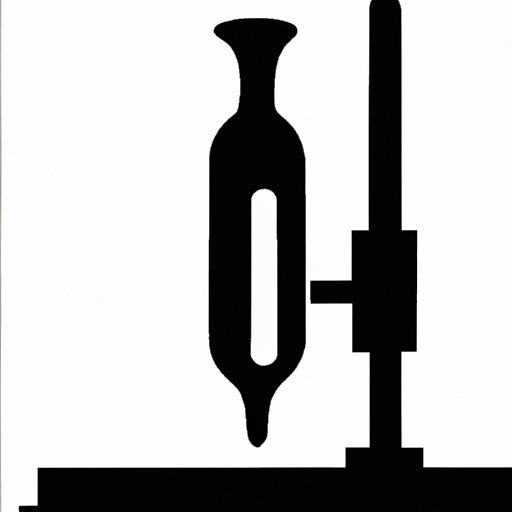Introduction
A scale is an instrument that is used in science to measure quantities accurately. Scales come in a variety of shapes and sizes and are used to measure a range of physical properties such as length, weight, temperature, pressure, and more. In this article, we’ll explore the definition of a scale in science, overview the different types of scales used in scientific research, discuss how to measure using a scale in science, and examine the role of a scale in accurately measuring quantities.
Definition of a Scale in Science
A scale is an instrument used to measure the quantity of a particular property, such as weight or length. The instrument typically consists of a graduated measuring device, such as a ruler, balance, thermometer, or barometer, and a pointer or indicator that indicates the measured value. Scales can be used to measure a wide range of physical properties, including length, weight, temperature, pressure, and more. Some scales are designed to measure multiple properties at once, such as a multi-purpose digital scale.

Overview of Different Types of Scales Used in Scientific Research
There are many different types of scales used in scientific research, each with their own unique advantages and disadvantages. Some of the most commonly used scales include:
- Balance Scales: Balance scales are used to measure the weight of an object by balancing it against a known weight on the other side of the scale. This type of scale is often used in laboratory settings to measure the mass of small objects, such as chemicals and samples.
- Spring Scales: Spring scales measure the weight of an object by measuring the amount of force needed to move a spring. This type of scale is often used in industrial settings to measure the weight of heavier objects, such as boxes or crates.
- Dial Scales: Dial scales measure the weight of an object by reading a dial that is attached to a spring. This type of scale is often used in grocery stores to weigh produce and other items.
- Digital Scales: Digital scales measure the weight of an object by reading a digital display. This type of scale is often used in medical settings to measure the weight of patients.
- Gravity Scales: Gravity scales measure the weight of an object by measuring the gravitational force exerted on the object. This type of scale is often used in astronomy to measure the mass of planets and stars.

How to Measure Using a Scale in Science
Using a scale in science requires careful preparation to ensure accurate results. Before measuring, it is important to choose the right type of scale for the job. Additionally, it is important to make sure the scale is properly calibrated and that all equipment is clean and free from debris. Once the scale is ready, the process of measuring can begin.
To measure using a scale, the sample must be placed on the scale’s platform. The scale will then read the weight of the sample and display the result on the display screen. If the scale is equipped with a tare function, the weight of the container can be subtracted from the total weight of the sample to get the net weight. It is important to note that the accuracy of the measurement depends on the quality and accuracy of the scale.

Understanding the Benefits of Using a Scale in Science
Using a scale in science provides many benefits, including the ability to measure a wide range of physical properties accurately and precisely. For example, using a digital scale can provide an accurate reading of a patient’s weight in just seconds. Additionally, using a scale can help reduce errors in measurement, as it eliminates the need to manually calculate measurements, which can lead to inaccurate results.
Accurate measurements are essential for scientific research, as they provide the data necessary to draw valid conclusions. According to a study published in the journal Nature Methods, “accurate measurements are essential for any scientific experiment; without them, valid conclusions cannot be drawn.” The study also found that using a scale in science can improve the accuracy of measurements and help ensure that the data collected is reliable and valid.
Examining the Role of a Scale in Accurately Measuring Quantities
The use of scales has been a part of scientific research for centuries. In fact, the first scales were developed in ancient Egypt and Babylon, and have evolved over time to become the sophisticated instruments used in modern science. Today, scales are used in a wide range of applications, from measuring the mass of planets and stars to weighing samples in laboratories.
Scales are used to measure a wide range of physical properties, including length, weight, temperature, pressure, and more. In order to achieve accurate results, it is important to select the right type of scale for the job and to make sure the scale is properly calibrated. Additionally, it is important to use the correct technique when measuring, as some techniques can lead to inaccurate results.
Conclusion
Scales are an essential tool for scientific research, as they allow scientists to measure a wide range of physical properties accurately and precisely. From measuring the mass of planets and stars to weighing samples in laboratories, scales play an important role in ensuring the accuracy of data collected in scientific experiments. By understanding the definition of a scale in science, exploring the different types of scales used in scientific research, discussing how to measure using a scale in science, and examining the role of a scale in accurately measuring quantities, we can better appreciate the importance of accurate measurement.
(Note: Is this article not meeting your expectations? Do you have knowledge or insights to share? Unlock new opportunities and expand your reach by joining our authors team. Click Registration to join us and share your expertise with our readers.)
